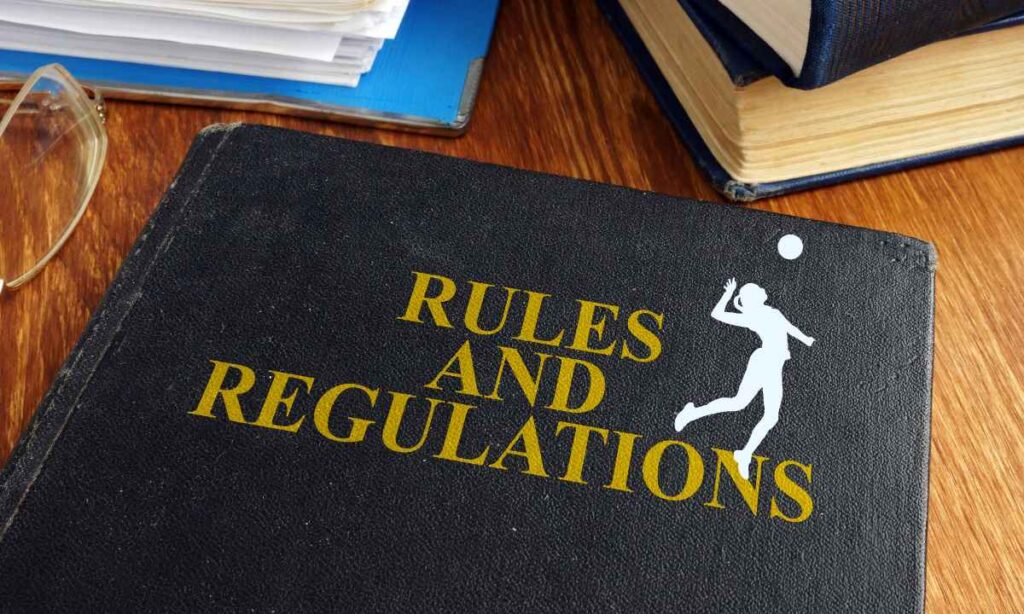Volleyball is a game that captivates millions, from the beach courts to the professional arenas. But one question that often baffles both beginners and seasoned players is, “Can you kick the ball in volleyball?“
The uncertainty around this rule can lead to hesitation on the court and missed opportunities in crucial game moments. Many players might be surprised to learn that, according to the FIVB rules, kicking the ball is legal and counts as a hit, just like any other body part.
This surprising fact opens up a whole new dimension of gameplay. Join me as we dive deeper into this intriguing aspect of volleyball, examining when, why, and how you might use this unorthodox but legal move to your advantage.
Can You Kick the Ball in Volleyball Game?
Yes, you can kick the ball in volleyball at all game levels. Kicking the volleyball is legal according to the FIVB rules, and players can use any part of their body to play the ball, including their legs and feet.
In my extensive experience playing volleyball across 22 clubs and 81 tournaments, I’ve seen volleyball players utilize their feet in various ways. While it’s not a commonly used technique, it can be a lifesaver in certain situations. However, just because it’s allowed doesn’t mean it’s always the best option. Volleyball is a highly controlled sport, and using feet must be done with caution and skill. Knowing when to kick and when to use other body parts is crucial for success on the court.
At what level of volleyball is it illegal to kick the ball?
No matter what league you’re playing, it is not illegal to kick the ball in volleyball at any level of the game. Whether you’re playing in a local league, beach volleyball, collegiate match, professional tournament, or even the Olympics, the rules regarding kicking remain the same.
Understanding this rule might open new avenues of play, but it’s essential to recognize that volleyball primarily relies on hands and arms for control and precision. Utilizing a kick should be a strategic decision, requiring practice and understanding to be executed properly.
The FIVB Rules and Regulations of Kicking in Volleyball

Continuing on from our exploration of the legality of kicking in volleyball, it’s crucial to dive into the specific rules and regulations that govern this part of the game. As someone who has played in 618 matches, I’ve found understanding these official rules vital for personal performance and team success.
Kicking the ball in volleyball is not considered an illegal hit, as your foot is part of your body, and the ball may touch any part of your body. This means a kick counts as a legal contact and adheres to the same rules as other contacts with the ball. Here are some essential points to consider:
- Any Part of the Body: Players can hit the ball with any part of their body, including legs, feet, head, or arms, as long as they only touch the ball once.
- Three Contacts Maximum: A kick, whether legal or illegal, counts as a legal contract, and the ball cannot be touched more than three times by a team before crossing the ball over the net.
- Control is Key: While kicking is allowed, and the ball is considered a hit in volleyball, control is often sacrificed when using your feet. It’s a technique that should be used sparingly and with consideration of the situation on the court.
- Professional and Recreational Play: The rules concerning kicking are consistent across all levels of play, from recreational leagues to professional tournaments.
- Penalties: Though kicking the ball is legal, it can lead to penalties if done out of anger or in an unsportsmanlike manner. The spirit of the game must always be upheld no matter if it’s indoor volleyball or any international league.
While these rules make kicking a viable option, it’s worth repeating that there are better choices than kicking. Volleyball is a sport of finesse and strategy, and players typically rely on their hands and arms for the most control. Kicking can be a valuable tool in specific scenarios, but understanding when and how to use it is essential.
In the end, knowing the rules and regulations of how and when to use your feet in volleyball can enrich your understanding of the game and even enhance your performance on the court. Like any skill, it requires practice, awareness, and thoughtful application. Whether you incorporate kicking into your game or simply appreciate it as a strategic option, understanding the rules is key to playing with confidence and integrity.
So When You Should Not Kick the Volleyball?

Moving on to the practical side of things, it’s important to recognize that just because you can kick the ball in volleyball doesn’t mean you always should. In specific situations, there may be better choices than using your feet.
You’re allowed to use your head, hands, and arms, which provides better control in some scenarios. Let’s dive into these scenarios to understand why kicking may not always be the ideal response.
Serve
There are better approaches than kicking the volleyball during a serve. Volleyball serves require precision, power, and control, and using your foot to serve the ball will likely compromise all three. While it’s not against the rules, a kick serve in volleyball is far more challenging to execute effectively. Players should focus on mastering the various hand serves, such as underhand, overhand, or jump serves, to achieve the desired results.
Because of Anger
Kicking the ball out of frustration or anger is unacceptable behavior on the court. Sportsmanship and respect for the game should always be at the forefront. If a player resorts to kicking the ball in anger, it can result in penalties or even ejection from the volleyball match. Emotions can run high during intense competition but must be managed appropriately.
Out-Of-Bounds
If a ball is heading out of bounds, using a foot to try and save it might be tempting. However, this can lead to uncontrolled hits that further disrupt the game’s flow. In such situations, letting the ball go out and preparing for the next play is often wiser. Kicking at an out-of-bounds ball might also risk injury, especially near obstacles or spectators.
When You Are Using Your Hands
Your hands provide the greatest control and flexibility in playing the ball. If you’re in a position to use your hands, it’s almost always the better choice than using your feet. Whether setting, passing, or spiking, your hands allow for a wide range of techniques and precision that feet simply cannot match.
In essence, knowing when not to kick the ball with your foot is just as important as knowing when it might be a viable option. As players develop their skills and understanding of the game, they’ll find that hands offer more control, finesse, and variety in playing the ball. Kicking should be reserved for those rare instances where no other options are available, and even then, it should be done with care and consideration for the game’s integrity.
When Can You Kick the Ball in a Volleyball Match?
Now, having explored when not to kick the ball, let’s flip the coin and discuss the moments when kicking might actually be a strategic or necessary move. In certain situations, using your feet could be a game-saving action. Here’s a closer look at these instances:
Defense
In defense, quick reflexes are key. Sometimes, the ball comes at you so fast that there’s no time to position your hands correctly before hitting the ground. A quick kick is a great way to keep the ball in play and save a point in such moments. This move requires sharp instincts and can be essential to a player’s defensive toolkit.
While in Block
When you’re at the net and focused on blocking, the ball can sometimes end up at your feet. In these situations, a well-timed kick can save the ball and send it back to the other side of the net. It’s a tricky maneuver that can catch the opposing team off guard.
Chasing the Ball
A desperate kick might be your last resort when a ball goes out of bounds, and there’s no other way to reach it. This action should only be used when necessary, as it requires significant control and awareness of your surroundings to execute without risk of injury.
At the Net
If you find yourself close to the net and the ball is within reach of your feet, a gentle kick can push it over. This unconventional play might seem unorthodox, but it’s legal and can effectively surprise the opposing team.
In summary, while using feet in volleyball is often seen as a last resort, there are moments when a well-timed kick can be a valuable addition to a player’s repertoire. Understanding when and how to kick the ball requires practice, control, and awareness, and when executed correctly, it can turn the tide of a match.
How Many Times Can You Kick the Ball in Volleyball?

You can kick the ball in volleyball as part of a legal contact, and like any other hit, it cannot be touched more than three times by the same team during a volley.
In the dynamic game of volleyball, the rules allow players to use any part of their body to make legal contact with the ball. A kick counts as one of those legal contacts, and just like hitting the ball with your hands or other parts of your body, the same three-touch rule applies. After a team has used up its three allowed contacts, the ball must be sent over the net to the opposing team’s side.
This rule emphasizes the importance of teamwork and strategic planning in volleyball. Knowing when and how to use a kick, and understanding its place within the three allowed contacts, can add an extra layer to your game strategy.
Remember, while you’re allowed to kick the ball, there may be more effective methods than relying solely on this method. But having the skill in your arsenal can be a valuable asset whether it’s a desperate save or a calculated move, a well-timed kick can make a difference in a match, but always within the framework of the three-contact rule.
Does it Make Sense to Practice Kicking the Ball?
Certainly, practicing kicking the ball in volleyball does make sense, although it should not be the main focus of a player’s training.
Kicking the ball in volleyball might be a rare move, but it can be valuable in certain situations. Whether it’s a last-ditch effort to save a ball or a calculated play in defense, having the ability to kick the ball accurately can add an unexpected twist to your game.
However, it’s essential to remember that volleyball primarily relies on control, precision, and teamwork, and these are typically best achieved through the hands and arms. While practicing kicks can enhance your overall versatility as a player, your main focus should still be on the more traditional aspects of the game.
That said, spending some time developing your ability to kick a volleyball can lead to more options on the court and could be the difference in a tight match. Just like any other skill in volleyball, practice and understanding when and how to use it are key.
Conclusion
In the thrilling game of volleyball, the ability to kick the ball offers a unique and sometimes essential option for players and volleyball teams. Though not a primary method of playing the ball, kicks are legal according to FIVB rules of volleyball and can be used in various situations, such as in defense, while in a block, chasing the ball, or at the net.
Despite its legality, there are scenarios where kicking the ball might not be the best choice, like during a serve or out of anger. It’s also crucial to remember that a kick, like any other contact, falls under the three-touch rule, limiting its use in a volley. Practicing this skill can benefit but should maintain traditional training.
Ultimately, the ability to kick the ball adds another layer to a player’s arsenal, reflecting the dynamic nature of volleyball, where strategy, agility, and the knowledge of when to apply different techniques make the sport both challenging and exciting.
FAQs
Are Kick Serves Legal in Volleyball?
Yes, kick serves are legal in volleyball. However, they are rarely used as they can be challenging to control, and using hands and arms provides better accuracy and power.
Can You Kick in Volleyball Olympics?
Yes, kicking the ball is legal in the Olympics. The Olympic volleyball games follow the same rules as regular volleyball, allowing players to use any part of their body, including legs and feet, to play the ball.
Is Kicking Allowed in Volleyball?
Absolutely, kicking is allowed in volleyball. Players can use any body part to hit the ball, including their legs and feet. While not always the best option, it’s legal and can be useful in specific situations.
How Many Leg Touches Are Allowed in Volleyball?
A kick counts as one touch, and in a volleyball game, a team is allowed only three touches before the ball must be sent over the net. There’s no specific limit on leg touches alone, but the total number of touches, including kicks, must not exceed three during a play.

![Can You Kick the Ball in Volleyball [Volleyball Rules]](https://volleyballvictories.com/wp-content/uploads/2023/08/Can-You-Kick-the-Ball-in-Volleyball-Volleyball-Rules.png)